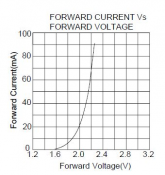ron
Apprentice elf
Nevermind, I should know better than to post after a long day, lol
Ron
Ron
Follow along with the video below to see how to install our site as a web app on your home screen.
Note: This feature may not be available in some browsers.

budude said:I guess I need to change my userid to "Doubting Thomas"...
I'm guessing that the same Piranha LEDs are used for the RFs as the RWRs and they are rated at 30mA so I find this hard to believe they are running at 170mA? It almost sounds you are an entire magnitude off (i.e. digit needs to move over one to .035A or 35mA/2) and perhaps they are 20mA LEDs so they are getting 17mA each which would be reasonable. Greg mentioned using 20mA LEDs at one point and 30mA later on but not sure if it applies to these...
ponddude said:Eddy,
Can you please verify that you got a 2ohm resistor? The bands you specified are for a 1 ohm resistor, which is what should be on the wall runners. I had to think about it and verified it here:
http://www.sizes.com/materls/resistorcolor.htm
I don't think you should have gotten a 2 ohm, but stranger things have happened. Just make sure that you did and I will send you replacements. BROWN, BLACK, GOLD, GOLD, however = 1 ohm @ +/-5%
Greg
AussiePhil said:ponddude said:Eddy,
Can you please verify that you got a 2ohm resistor? The bands you specified are for a 1 ohm resistor, which is what should be on the wall runners. I had to think about it and verified it here:
http://www.sizes.com/materls/resistorcolor.htm
I don't think you should have gotten a 2 ohm, but stranger things have happened. Just make sure that you did and I will send you replacements. BROWN, BLACK, GOLD, GOLD, however = 1 ohm @ +/-5%
Greg
Greg
This is getting ridiculous, 350mA of current through two parallel connected sets of five Red 30mA series connected LED's is just plain WRONG, the total current drawn by the two series strings should be 60mA and this certainly requires a resistor in at least Eddie's case of GREATER than TWO Ohms.... NOT a reduction back the the ONE Ohm you are promoting.
The current version of this design is inherently flawed with the use of five series connected RED LED's.
Phil
android said:AussiePhil said:ponddude said:Eddy,
Can you please verify that you got a 2ohm resistor? The bands you specified are for a 1 ohm resistor, which is what should be on the wall runners. I had to think about it and verified it here:
http://www.sizes.com/materls/resistorcolor.htm
I don't think you should have gotten a 2 ohm, but stranger things have happened. Just make sure that you did and I will send you replacements. BROWN, BLACK, GOLD, GOLD, however = 1 ohm @ +/-5%
Greg
Greg
This is getting ridiculous, 350mA of current through two parallel connected sets of five Red 30mA series connected LED's is just plain WRONG, the total current drawn by the two series strings should be 60mA and this certainly requires a resistor in at least Eddie's case of GREATER than TWO Ohms.... NOT a reduction back the the ONE Ohm you are promoting.
The current version of this design is inherently flawed with the use of five series connected RED LED's.
Phil
Phil
Just out of curiousity,
would you please share your calculations that proves why the design is "just plain wrong" and "inherently flawed"??
Thanks
RS

